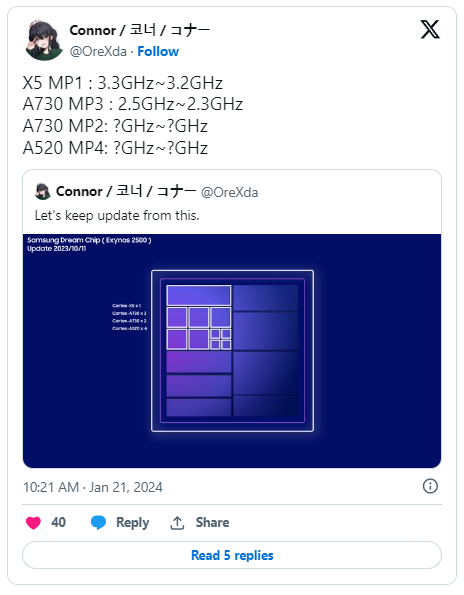Igeekphone January 21 news, Exynos 2400 performance and efficiency test just came out, the anecdotal Exynos 2500 successor (also known as Samsung Dream chip) details have surfaced. According to the latest news, this upcoming SoC will continue to use the previous generation’s 10-core CPU architecture, while introducing a new Cortex-X5 core.

It was previously rumored that the Exynos 2500 was testing a quad-core Cortex-X architecture, but the source @OreXda shared the latest information, saying that Samsung is testing a different core combination. Using too many Cortex-X cores can lead to power loss, and the Exynos 2500’s 10-core CPU architecture will be consistent with the Exynos 2400.
However, Igeekphone notes that the upgrade to the Exynos 2500 will be the Cortex-X5 and Cortex-A730 cores, which are expected to significantly improve performance compared to the Cortex-X4 and Cortex-A720 of the Exynos 2400. Unfortunately, the difference in clock frequency between the Cortex-X5 and Cortex-X4 is minimal, with the test frequency between 3.20GHz and 3.30GHz. Depending on Samsung’s final decision, there may be only a slight boost of 100MHz, or even no difference at all.

In addition, the Exynos 2500 is expected to feature dual Cortex-A730 clusters running at different clock frequencies, similar to the Exynos 2400 design. As for the low-power core, the source pointed out that both the old and new generations of chips will use the same Cortex-A520, but the specific frequency has not been revealed.
Samsung Exynos 2500 chip is likely to be mass-produced using the company’s state-of-the-art 3nm GAA process, which is not yet used in any smartphone or tablet chips. The Exynos 2400 uses a 4LPP + process, so it is logical that the Exynos 2500 uses a more advanced process. At present, the Exynos 2400 has performed well in the 3DMark benchmark test, and we expect Samsung to further improve its performance in the next generation of products.









